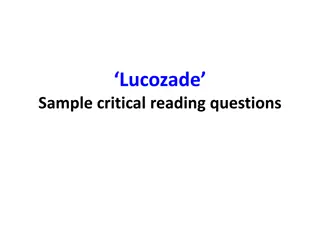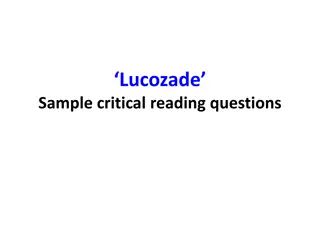Understanding the Imperative Mood in Language
The imperative mood focuses on giving commands without reference to different time frames. It entails direct statements with the understood recipient mainly being 'you.' Commands in the singular, informal form involve dropping the 's' from the second person singular verb, both in affirmative and negative forms. Furthermore, irregular verbs have specific forms for commands. Remembering direct object pronouns in commands is essential for clarity and accuracy in communication.
Download Presentation

Please find below an Image/Link to download the presentation.
The content on the website is provided AS IS for your information and personal use only. It may not be sold, licensed, or shared on other websites without obtaining consent from the author. Download presentation by click this link. If you encounter any issues during the download, it is possible that the publisher has removed the file from their server.
E N D
Presentation Transcript
* The imperative deals with one aspect of the language, and that is giving commands. We call the imperative a mood because commands do not move among the various time frames as do the tenses. The only time frame involved in a command is now: Clean your room, now!
* Statements in the imperative are direct. There are no qualifiers, such as I want you to clean your room or you should clean your room. The message is straightforward, and often can contain as little as one word: Go! Stop! Look! Wait! Listen!
* The understood recipient of any command is you. Even when admonishing yourself to do something, you are speaking go yourself as you (in Spanish, in the t form). We can, however, give wecommands, meaning you andI, which in English usually begin with: Let s. Let s dance; Let s eat; Let s go.
Commands in the t (singular, informal) form: To form a regular affirmative command, simply drop the s from the conjugated verb of the second person singular: Hablas - You speak becomes Habla! - Speak! Comes - You eat becomes Come! - Eat! Vives - You live becomes Vive! - Live!
Regular verbs negative Do the following rules steps for the negative regular: Take the present tense yo form of the verb. Remove the o (or the oy in the verb estar). For ar verbs, add es; for er and ir verbs, add as. Ex: no hables don t speak no comas don t eat no escribas don t write
Remember car/gar/zar Since in the negative you take an ar verb and plug in an e the car/gar/zar rule applies. C qu g gu z c Tocar = no toques el piano = don t play the piano. Jugar = no juegues al beisbol = don t play baseball. comenzar = no comiences = don t begin.
Irregular verbs infinitive affirmative negative Decir Hacer Di Haz No digas No hagas Ir Ve No vayas Poner Pon No pongas Salir Sal No salgas Ser S No seas Tener Ten No tengas Venir Ven No vengas
Remember direct object pronouns Direct object (recipient of verb) for whom for what Me -me Nos- us Te -you,(familiar) Os - you all (fam.) Lo you, it (masc.), him Los you, them (m.) La you, it (fem.), her Las you, them (f.) Indirect object (recipinent of the direct object) to whom or for whom is the DO. Me to, for me Nos - to, for us Te -to, for you (familiar) Os to, for you all (fam.) Le to, for you, him, her Les to, for you all, them Reflexive (subject and recipient) Me myself Te -yourself se hersela Nos - ourselfs Os yourallselfs se theirselfs
Affirmative commands with direct object pronouns With an affirmative command, the object pronoun(s) will be attached directly to the end of the verbs in its imperative form. Ex: Estudialo= study it hazme un favor = do me a favor dame el libro = give me the book dejame en paz = leave me alone levantate = you stand up
Two object pronouns When there are two object Pronouns remember the rule RID. Reflexive; Indirect; Direct. In addition Remember de lela rule . EX: Dalelo = daselo Give it to him. Examples: Tell it to me = dimelo Give them to me = damelas Buy it for yourself = Compratelo
Negative commands with object pronouns With a negative command, the object pronoun(s) will precede the verb in its imperative (regular) form. The object pronoun will be before the conjugated verb. The rule RID will apply . Reflexive; Indirect; Direct. No me mires = Don t look at me. No lo pongas alli = don t put it there. No se las digas = Don t tell lies to them. No se los compres = don t buy them for him.
Commands in Usted (formal) For regular verbs, to form an affirmative or a negative command, do the following. Take the present tense yo form of the verb. Drop the o ending (or oy in the verb estar) For ar, verbs add an e; for er and ir verbs, add and a (don t forget the other changes in other slides. EX:
Examples commands in the usted form Hable = speak Coma = eat Escriba = write Ponga = put Tenga = have Traiga = bring D = give
Irregular formed usted commands In the usted form, only three verbs have irregularly formed command. These are: infinative imperative English ir vaya go saber sepa know ser sea be
Commands in the ustedes(plural, formal) form: Commands in the ustedes form are identical to those in the usted form, with the single exception that an n is added to the usted imperative. This is true for all verbs. Regular and irregular. Hablen = speak. No coman = don t eat. Escriban = write. Sean amables = be kind.
Commands in the nosotros form Commands in the nosotros (we) form generally translate to Lets statements in English. Let s eat ; Let s go. To form these commands in regular Spanish verbs, you will do the following three steps.
Three steps 1. Take the present tense yo of the verb 2. Remove the o or oy. You now have the yo stem . 3. For ar verbs, add emos; for erand ir- verbs, add amos. Let s talk= hablemos! Let s eat = comamos! Let s write = escribamos
Things to note 1. Stem changing verbs- except stem-























